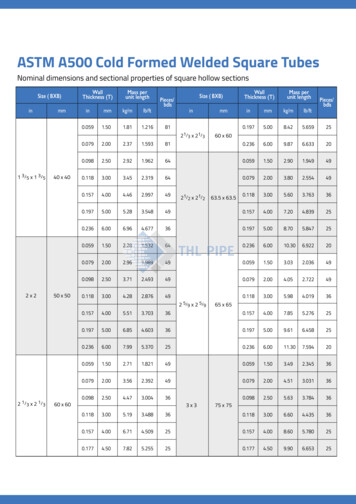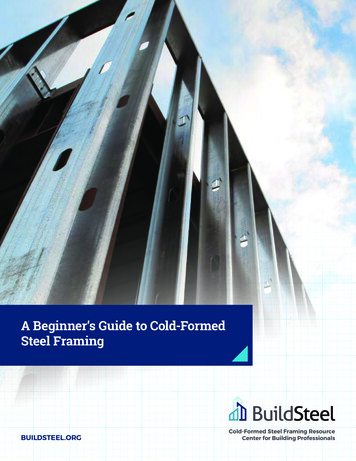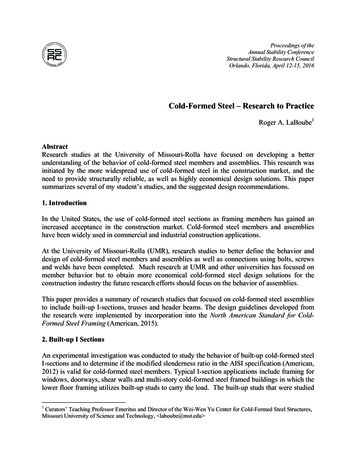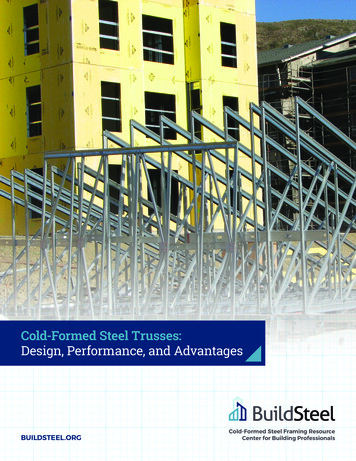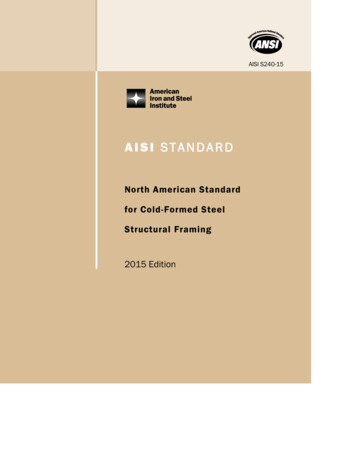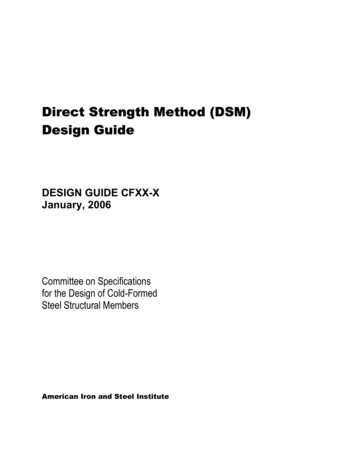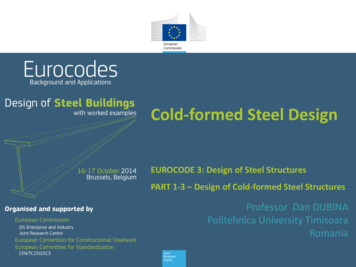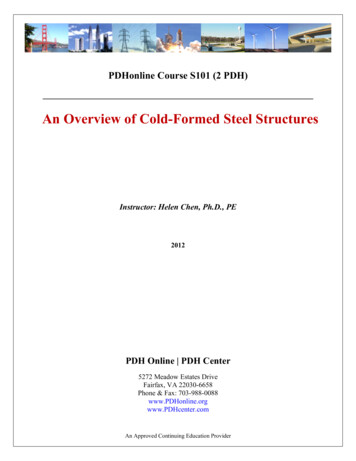
Transcription
PDHonline Course S101 (2 PDH)An Overview of Cold-Formed Steel StructuresInstructor: Helen Chen, Ph.D., PE2012PDH Online PDH Center5272 Meadow Estates DriveFairfax, VA 22030-6658Phone & Fax: 703-988-0088www.PDHonline.orgwww.PDHcenter.comAn Approved Continuing Education Provider
www.PDHcenter.comPDH Course S101www.PDHonline.orgAn Overview of Cold-Formed Steel StructuresHelen Chen, Ph.D., PECourse OutlineCold-formed steel has been widely used in building construction, from residential housesto industrial buildings. This two-hour course discusses the manufacturing process of coldformed steel, the fundamental theories of cold-formed steel design, advantages of coldformed steel over other construction materials, cold-formed steel applications in today'sconstruction market, and the connection methods. This course includes a multiple-choicequiz at the end, which is designed to enhance the understanding of course materials.Learning ObjectiveAt the conclusion of this course, the student will: Understand the manufacturing process of cold-formed steel;Understand the effect of cold-work;Understand the structural behavior of cold-formed steel;Be familiar with the current design method for cold-formed steel;Be familiar with the cold-formed steel products;Be familiar with the types of connections used for cold-formed steel; andBe familiar with the industry standard nomenclature and color-coding scheme forsteel studs and tracks.Course ContentCold-formed steel offers versatility in building because of its lightweight and ease ofhandling and use. Did you know that cold-formed steel represents over 40 percent of thesteel construction market, and this share is increasing?What is Cold-Formed Steel?In building construction, there are primarily two types of structural steel: hot-rolled steelshapes and cold-formed steel shapes. The hot-rolled steel shapes are formed at elevatedtemperatures while the cold-formed steel shapes are formed at room temperature. Coldformed steel structural members are shapes commonly manufactured from steel plate,sheet or strip material. The manufacturing process involves forming the material byeither press-braking or cold roll-forming to achieve the desired shape. Examples of thecold-formed steel are corrugated steel roof and floor decks, steel wall panels, storageracks and steel wall studs.Press-braking is often used for production of small quantity of simple shapes. Cold rollforming is the most widely used method for production of roof, floor and wall panels. It isPage 1 of 18
www.PDHcenter.comPDH Course S101www.PDHonline.orgalso used for the production of structural components such as Cees, Zees, and hatsections. Sections can usually be made from sheet up to 60 inches (1.5m) wide and fromcoils more than 3,000 feet (1,000m) long.During cold roll-forming, sheet stock is fed longitudinally through a series of rolls, eachof which works the sheet progressively until it reaches the desired shape (Figures 1 and2). A simple section may require as few as six pairs of roll, but a complex shape canrequire as many as 24 to 30. The thickness of material that can be formed generallyranges between 0.004 (0.10mm) up to 0.312 inches (7.9mm), although heavy duty coldforming mills can handle steel up to ¾ of an inch (19mm) thick.Figure 2Figure 1Effect of Cold WorkWhen steel is formed by press-braking or cold rolled-forming, there is a change in themechanical properties of the material by virtue of the cold working of the metal.When a steel section is cold-formed from flat sheet or strip, the yield strength, and to alesser extent the ultimate strength, is increased as a result of this cold working,particularly in the bends of the section.The right part of Figure 3 shows thedeveloped centerline of the sectionand the variation of yield andultimatestrengthalongthecenterline. One can see that thesestrengths are unaffected in thethree flat portions where little coldwork has taken place and thestrength is much higher in thecorners, which have been stronglycold-worked in the forming process.Figure 3Since cold work produced during forming increases the strength of the steel, it permitsthe designer to treat the formed steel as a stronger material than the original unformedsteel. Often, it is possible to take a weighted average of the post-forming strength of thecross section and use this higher figure as the overall strength of the steel.Page 2 of 18
www.PDHcenter.comPDH Course S101www.PDHonline.orgA shape that is cold worked to a higher degree will have a higher yield strength, whichmay make it more appropriate for certain applications. Sometimes cold work is added byoverbending and straightening. The end result is that a more complex shape may havehigher strength than a less complex shape. Other factors that can affect cold workinginclude roll pressure, corner radius and the properties of the steel.Depending on the type of cold-forming and the thickness of the steel, the amount ofstrength increase could reach 20% to 50%. However, the ductility of the steel is reducedas result of cold-forming process.Properties of Cold-Formed SteelGenerally, the grades of carbon steel and high strength low alloy steel used for coldformed steel products are characterized by two main properties: the yield point and thetensile strength. Other important properties are ductility, hardness and weldability.The yield point of the steels commonly used for cold-forming ranges from 33 to 55 ksi(230 to 380 MPa), and may be higher. Tensile strength and ductility are importantbecause of the way they relate to formability, and because of the local deformationdemands of bolted and other types of connection. In members that include boltedconnection or that, because of special design, may be subject to high stressconcentrations, the tensile strength often must be taken into account. The ratio of tensilestrength to yield strength for cold-formed steels commonly ranges from 1.2 to 1.8.However, steels with a lower ratio can be used for specific applications.Cold-Formed Steel TypesFigure 4There are two major types of cold-formed steelproducts: structural shapes and panels. Of theformer, there are a variety of shapes produced. Theyinclude open sections, closed sections, and built-upsections, such as Cee sections (also called lippedchannels), zee sections, double channel I beams withstiffened flanges, hat sections with and withoutintermediate stiffeners, box sections, U sections andothers. These are used in buildings for such structuralfunctions as eave struts, purlins, and girts as well asjoists and studs and other components.Generally, the depth of cold-formed individual framing members range from 2 to 12inches (50 to 300mm) and the thickness of material ranges from 0.035 to about ¼inches (0.90 to 6.4mm)Page 3 of 18
www.PDHcenter.comPDH Course S101www.PDHonline.orgCold-Formed Steel vs. Hot-Rolled SteelThe differences between cold-formed and hot-rolled steel are not just in the thicknessand the shapes. Since cold-formed steel members are formed at room temperature, thematerial becomes harder and stronger. Its lightweight makes it easier and moreeconomical to mass-produce, transport and install.One of the main differences between designing with cold-formed steel shapes and withhot-rolled structural shapes is that with the hot-rolled, one is primarily concerned abouttwo types of instability: column buckling and lateral buckling of unbraced beams. Thedimensions of hot-rolled shapes are such that local buckling of individual constituentelements generally will not occur before yielding.This is not the case with cold-formed members. Here local buckling must also beconsidered because, in most cases, the material used is thin relative to its width. Thismeans that the individual flat, or plate, elements of the section often have width tothickness ratios that will permit buckling at stresses well below the yield point.Local BucklingLocal buckling, for such plateelements, is not the same as overallbeam or column buckling. Althoughthe element begins to deflect out ofits original straight or plane shape,it does not fail when the initialbuckling stress is reached. On thecontrary it can resist increasingcompression stresses often well inexcess of those at which localbuckling first appears.In this case, the member developsout-of-plane deformations which areshown (highly exaggerated) forthese beams and columns, but theywill continue to carry increasingload. This is known as their postbuckling strength.Figure 5There are two types of thin, compressed sheet elements. One type is stiffened by othercomponents along both longitudinal edges. Such elements are called stiffenedcompression elements, and you see them in the compression flange of the C-sectionbeam, or in all four faces of the box column. The other type is called unstiffenedcompression elements that are stiffened only along one of the two longitudinal edges.The other edges remain free. These elements appear in the compression flange of thechannel section beam, and in all flanges of the I-section column. The behavior of thesetwo types of elements is similar, though not identical.Page 4 of 18
www.PDHcenter.comPDH Course S101www.PDHonline.orgEffective Width and Effective PropertiesThe concept of effective width is the key to the design of cold-formed steel. Consideringthe element as the compression flange of some member (see Figure 6), the totalcompressive force is the area under this stress distribution curve, times the thickness ofthe element. What is needed in design, really, is only this total compressive force. It isconvenient to replace the actual variable stress distribution with a fictitious uniformstress distribution, of the same intensity of the edge stress, f, as in the real element asindicated by the dotted lines.Figure 6Figure 7In order to get the same total compression force in the fictitious (dotted) as in the real(solid) distribution, the areas under the two must be equal. This means adjusting thewidth of each of the two fictitious rectangles, b/2, until the combined area of the tworectangles is equal to that under the solid curve. This width is known as the effectivewidth, b.Once this effective width, b, is known, structural members, such as beams or columns,can be designed simply by replacing the real width, w, of each compression element byits effective width, b. This is shown for several frequently used shapes in Figure 7. To theleft is a flexural member, to the right a compression member. The two effective portionsof the compression elements are shown solid, and the portions considered removed aredotted. For each element, the total effective width is, of course, b (or b1).Then, effective section properties, such as area, section modulus, and moment of inertia,can be calculated by using for each compression element its effective width, b, instead ofits real width, w.Effective Width EquationThe basic equation for the effective width, b, are the result of very extensive research,and are shown below:Page 5 of 18
www.PDHcenter.comPDH Course S101www.PDHonline.orgThe effective width is calculated by multiplying theactual width, w, by a reduction factor ρ, when theslenderness parameter λ is greater than 0.673. As λincreases the effective width decreases.Figure 8It is seen that the slenderness parameter, λ, dependson the ratio of actual width to thickness (w/t), theplate buckling coefficient, k, and the maximum edgestress, f. λ increases with the increasing edge stress,f, and also with increasing flat width-to-thicknessratio, w/t.Figure 9Stiffened vs. Unstiffened SectionsA thin, flat sheet of steel cannotsupport much weight, but if it isformed into a corrugated sheet,the folds act as stiffeners, andcan increase the strength of thesame sheet many times over.The load-carrying capacity ofthe compression components inbeams or columns can beincreased significantly by theuse of the edge stiffeners orintermediate stiffeners. The lipon the flanges of C-shaped steelstuds is an example of edgestiffener.Figure 10When a compression component has stiffeners on along two parallel edges, it isconsidered as a fully stiffened or partially stiffened section depending on the stiffness ofthe stiffeners. When a compression component has the stiffener along one edge only, itis considered as an unstiffened section. The flanges of C-shaped steel studs areexamples of fully or partially stiffened sections while the flanges of U-shaped steel trackare examples of unstiffened sections.Page 6 of 18
www.PDHcenter.comPDH Course S101www.PDHonline.orgApplications of Cold-Formed SteelCold-formed shapes can be used for entire buildings and for complete roof, floor and wallsystems. They can also be used as individual framing members such as studs, joists andtruss members.From structural standpoint, the cold-formed steel can serve as both primary structuresand secondary structures. An example of the cold-formed steel used as primarystructures is the steel stud load-bearing wall. Steel studs providing the lateral support toexterior wall finish are usually secondary structures since they rely on the primarystructure for support.Figure 11There are two major types of cold-formed steelproducts: structural shapes and panels. Of theformer, there are a variety of cold-formed structuralshapes available on the market. They include opensections, closed sections and built-up sections. Cee-,zee-, double channel I-sections, and hat sections areopen sections while box sections and pipes are closedsections. These structural shapes can be used inbuildings as eave struts, purlins, girts, studs, headers,floor joist, braces and other building components.Regular DecksFigure 12Floor decks, roof decks and wall systems are theprime applications for cold-formed steel in panel form.These are made in both simple, or single-componenttypes, as well as more complex units made up ofseveral elements. Permanent metal deck forms ht steel in thickness that vary from 0.020 to0.075 inches (0.50 to 1.9mm) and depths of 2, 3, and4-1/2 inches (51, 76 and 115mm), depending on slabthickness and design span.Permanent metal deck forms are designed to support the wet weight of concrete, aconstruction load, reinforcing steel and the weight of the form itself.Composite metal deck forms also provide the tensionreinforcement for the slab. The embossments provideinterlock between the deck and the concrete. The ribsare generally trapezoidal in shape for roof and floordeck applications, although they may vary bymanufacturer. The panels may be punched with apattern of holes to absorb sound.Figure 13Page 7 of 18
www.PDHcenter.comPDH Course S101www.PDHonline.orgMulti-Function DeckSome deck systems use cellular cold-formed steelshapes to permit lightweight floors that reducedeadweight. These floor systems can provideelectrical power, communications and data cabledistribution as well as heating and air conditioningducts.Figure 14This eliminates separate space requirements in floors,walls and ceilings for ductwork or conduit systems.The modular construction possible with cold-formedsteel sectionspermits access to many points in the deck, making it easy to rearrange wiring orventilation outlets.Standing Seam Metal RoofThe cold-formed steel standing seam roof wasintroduced in 1969 as a new concept in roofing.Today, there is over a billion square feet of standingseam roofing installed.Figure 15The system consists of factory or job-site roll-formedpanels with elevated, field-secured seams andconcealed clips that fasten the panels to the structureand permit the panels to accommodate thermalexpansion and contraction.There are two basic types of standing seam roof systems:Figure 16The first type is structural standing seam roof panelsthat provide a water-tight barrier and are generallyinstalled on low-slope applications, with a minimumslope of about ¼ in 12. These panels provide theirown support, usually spanning about five feet (1.5m)between purlins. The system can also be installedover existing flat roofs by using a sloped subassembly system made of light steel structurals. The"attic" created by the sub-assembly affords aconvenient area of adding insulation.Leaving the old roof in place means avoiding the release of potentially hazardousmaterials into the environment and eliminating the cost of disposing of the existing roof.Most importantly, a new metal roof can be installed with little or no interruption to thebuilding’s occupants. The preferred material for the roof panel is galvanized oraluminum-zinc coated sheet steel.Page 8 of 18
www.PDHcenter.comFigure 17PDH Course S101www.PDHonline.orgThe second type is architectural standing seam roofpanels. They are generally used on roofs with slopesof 3 to 12 or greater, and provide water protection aswell as aesthetic value. These panels usually requiresome form of decking for support. The preferredmaterials for architectural standing seam roof panelsare prepainted galvanized and prepainted aluminumzinc coated sheet steel. The architectural possibilitiesprovided by the variety of colors and patterns arelimitless.Insulated PanelCold-formed steel panels are also used for enclosing the building to keep out the weatherand keep in the heat. There are now available cold-formed steel panels with insulationalready incorporated in the construction of the panel. Some of these configurations makeuse of foamed in place rigid urethanes sandwiched in between the steel. Others usedifferent types of insulation, the more conventional being fiberglass installed in thepanels.Wall PanelsThere are wide varieties of panel systems. The simple,single element is available primarily as a ribbedsheet; formed, coated and otherwise modified to fulfillspecial functions that may be required.Panels for walls may be as straightforward as apainted ribbed panel or as interesting as a porcelainor metal and glass curtain wall system.Figure 18In many metal buildings, the wall panel is similar to the ribbed roof panel, with eitherwide or narrow ribs, and is painted or aluminum coated for long service life. The sametongue and groove lap or standing seam joints is employed here.More sophisticated systems are made from coldformed steel for curtain wall systems of buildings.These may include varying amounts of glass, eithertinted or clear, complex or simple trim work and cleanexpanses of sheet steel.Figure 19Page 9 of 18
www.PDHcenter.comPDH Course S101www.PDHonline.orgThere are many advantages in using these cold-formed steel curtain walls. They includehigh strength and lightweight, and modular installation for lower construction costs. Theypermit a beautiful surface, available in a variety of coatings, textures and colors to meetany architectural concept. Like other panels, these may have insulation pre-installed. Thecurtain wall module may span several window bays or several floors, to minimizeinstallation time.Exterior WallsMetal stud framing is widely used as the structuralsupport for the exterior brick veneer and exteriorinsulation finishing system (EIFS). A stud wallframing is a wall system with studs connected to thetop and bottom tracks and braced with cold-rolledchannel bridging or diagonal bracing. The stud wallsystem can be used to carry the floor load (loadbearing wall), to resist the lateral load such as windor seismic load (curtain wall), or to provide lateralstability for the building (shear wall).Figure 20Stud wall framing has been widely used in both non-load-bearing and load-bearingconstruction.Building Interior Partitions and EnclosuresCold-formed steel framing is also used for interior walls and partitions that provideflexibility in layout of interior spaces as well as the freedom to relocate and redesign. Inaddition, cold-formed steel framing is used to support the shaft walls, ceilings, and ductenclosures.Residential UsesAnother area in construction where cold-formed steel isfinding wider application is in residential steel framingsystems. Here, steel is used instead of lumber for joists,studs and other structural components of residentialconstruction. The steel components are usually of Cee, Ior hat shape and galvanized or painted. They can be cutto the required length by the manufacturers, therebyminimizing construction labor.Figure 21Page 10 of 18
www.PDHcenter.comPDH Course S101www.PDHonline.orgCulvertsCold-formed, corrugated steel pipes are used foreverything from storm sewers to utility tunnels, andfrom simple tunnels under roadways to huge bridgestructures. The corrugated steel pipe can be installed ina cut, then covered with fills and topped out with aroadway to form an inexpensive and durable bridge.Figure 22 (Source: NCSPA)Floor and Roof TrussesFigure 23 (Source: DietrichIndustries)Cold-formed steel trusses have gained a significantmarket share in recent years. They can be made fromregular C-section studs or from other proprietaryshapes. Cold-formed steel trusses provide the samespan capabilities and design flexibilities as wood trusses,yet they are lighter and more dimensionally stable thanwood trusses. Most cold-formed steel roof trusses arepre-engineered and prefabricated using computersoftware, which makes it possible to accommodatevarious roof configurations. This design flexibility makescold-formed steel trusses ideal for almost any buildingtype – residential, commercial, institutional, educationaland industrial structures.RacksMaterial handling and storage specialists rely on coldformed steel racks and rack systems to efficiently storeand retrieve everything from groceries to heavy steelbars. New rack systems are so huge that they fill entirebuildings and have stacker cranes that rise as high as100 feet (30m).Figure 24Page 11 of 18
www.PDHcenter.comPDH Course S101www.PDHonline.orgPre-Engineered BuildingsThere is a whole industry built around cold-formed steelbuilding components. Manufacturers of pre-engineeredmetal building provide custom designed structures foranything from a small tool shed to a range ofsophisticated structures such as schools, churches andother complex manufacturing facilities.Figure 25Other ApplicationsCold-formed steel is also used for a variety of building products such as doors andwindows. In highway construction, cold-formed steel is also used for guardrails, medianand glare barriers, permanent bridge deck forms, signs and other components.Advantages of Cold-Formed SteelCold-formed steel products are shaped at ambient temperature from steel sheet, stripplate or flat bars by roll-forming machines, press brakes or bending brake operations.They can be produced in large quantity and at high speed with consistent quality. Atypical automated rolling machine can run at a speed range of 75-150 feet per minute,and the products can be as small as a three-quarter inch wide cold-rolled channel sectionto as big as a thirty-six inch wide roof deck section. In addition, cold-formed steelpossesses many other superior advantages over other construction materials:1. Lightweight - Cold-formed steel weighs significantly less than wood and masonrymaterials. A typical stud wall weights only 10% to 15% of the masonry wall, whichmeans easy handling during the construction and transportation.2. High strength and stiffness – As a result of the cold-forming process, cold-formedsteel possesses one of the highest strength-to-weight ratios of any buildingmaterials. This high strength and stiffness advantage means better design flexibility,wider spans and better material usage.3. Fast and easy erection and installation – Building components made of cold-formedsteel can be fabricated with high accuracy in a plant and then assembled on jobsites, which greatly increases erection efficiency and ensures construction quality.4. Dimensionally stable - Cold-formed steel does not expand or contract with moisturecontent. In addition, it does not split or warp as time goes by and, therefore, isdimensionally stable. Cracked sheetrock walls, nailhead popping and other commonproblems with wood framed structures can be virtually eliminated in buildings withcold-formed steel stud walls.5. No formwork needed – The use of cold-formed steel decks eliminates the formworkfor pouring concrete floor. In addition, composite action between the steel deck andconcrete increases floor strength and stiffness.Page 12 of 18
www.PDHcenter.comPDH Course S101www.PDHonline.org6. Durable - Cold-formed steel is durable because it is termite-proof and rot-proof. Inaddition, galvanized cold-formed steel products can provide long-term resistance tocorrosion.7. Economy in transportation and handling - The cold-formed members or panels areeasy to handle and to transport due to their lightweight. In addition, they can bestaggered and bundled, thus with small space occupancy.8. Non-combustible - Steel does not burn and will not contribute fuel to the spread of afire, which will result in better fire resistance and lower insurance premiums.9. Recyclable - Steel is an environment friendly "green" material. It can be recycledand reused. Steel-framed housing dramatically reduces the amount of treesconsumed for residential construction, thus conserving one of nature's most preciousresources.ConnectionsThe main forms of connections of cold-formed steel in construction are mechanicalfasteners, welding and seams of various designs.Seam TypesSeams are used on roof decks, corrugated steel pipesand in other products. Possible seam designs include thesingle lock seam, grooved single lock seam and battenseam. Others include the double lock standing seam,standing seam and double lock seam.Figure 24BoltsFigure 23With mechanical fasteners, and particularly boltedconnections, the ratio of bolt diameter to plate thicknessis usually much larger in cold-formed steel constructionthan in heavy construction. This means that largernumbers of smaller diameter mechanical fastenersshould be used in joining cold-formed sheet steelsections, although the general rules governing theirplacement are not unlike those of hot rolled structuralsteel. These general rules, however, are strongly subjectto modification for behavior in particular cases.Page 13 of 18
www.PDHcenter.comPDH Course S101www.PDHonline.orgSometimes it is necessary to conduct tests to determine the best type and placement offasteners, although for commercially available products, this information is supplied bythe manufacturer. Bolts are usually hex-head and are used with washers.ScrewsSelf-tapping and self-drilling screws are importantfasteners for cold-formed steel. They come in a varietyof lengths, diameters, strengths and coatings, and theiruse should be in accordance with the manufacturer’ssuggestions. Minimum penetration of screws shallinclude the thickness of joined material plus three (3)exposed threads.Figure 24Self-drilling screws drill and tap their own hole and are used with mechanical drivers.Because these types of screws require no pre-drilled hole, they are useful where lineupof the parts being joined is accomplished through other means before joining.These kinds of fasteners are used with steel framing systems for joining framingmembers to one another and for fastening sheathing material to the framing structure.For the latter job, there are many specialized types of screws, nails and staples. They aredesigned to anchor into both the framework and sheathing. Special coatings such ascadmium, zinc and other metals provide longer fastener life.Powder Actuated FastenersFigure 25Powder actuated fasteners, also called power nails, areused to connect cold-formed steel framing to concrete orstructural steel. Use of powder actuated fastenersenables speedy installation. The typical diameter ofpowder actuated fasteners is 0.145"φ for structuralapplications. A minimum ¾" penetration, 3" edgedistance, and 4" spacing in concrete is required. Instructural steel, minimum edge distance shall be ½" andminimum spacing 1½". The point of the fastener shouldbe driven completely through the backside of the hotrolled steel member or embedded minimum ½" into hotrolled steel.Page 14 of 18
www.PDHcenter.comPDH Course S101www.PDHonline.orgExpansion Anchors and Anchor ScrewsExpansion anchors and anchor screws are used to fastencold-formed steel framing to concrete or masonry. Theirload capacities are usually higher than that of powderactuated fasteners. A minimum 3" edge distance and 4"spacing in concrete and masonry are required for allexpansion anchors to achieve design load capacity.Figure 26Since it is necessary to drill a hole for each anchor, ittakes longer to install an expansion anchor or anchorscrew than a powder actuated fastener.Figure 27Welding is widely used for joining cold-formed sheetsteel parts. The two types of welds used are fusion andresistance. Fusion welding includes a group of weldtypes such as fillet welds, butt welds, plug welds andpuddle welds, in which sheets are welded together bybringing them to the molten state at the surface to bejoined by means of deposition of weld metal. Fusionwelds are often used for erection, joining one coldformed steel member to another or to hot-rolled framingmembers.WeldingResistance welding includes spot and projection welding. In this type of welding, coalescenceis produced by the heat obtained from resistance to an electric current passed through thework parts, which are held together under pressure by electrodes. Resistance welding ismostly used for in-shop fabrication of cold-formed steel components.If cold-formed steel members are welded, minimum steel thickness shall be 18 gauge (43mils). Special low amperage welding equipment and small diameter rods shall be used toprevent blowholes in the cold-formed steel. Typical welds for 12 gauge (97mils) and lightermaterials is 1/8" flare-groove or fillet welds. Welded areas shall be touched up with a zincrich paint.Page 15 of 18
www.PDHcenter.comPDH Course S101www.PDHonline.or
An Overview of Cold-Formed Steel Structures Helen Chen, Ph.D., PE Course Outline Cold-formed steel has been widely used in building construction, from residential houses to industrial buildings. This two-hour course discusses the manufacturing process of cold-formed steel, the fundamental theories of

